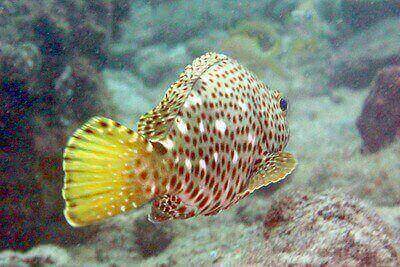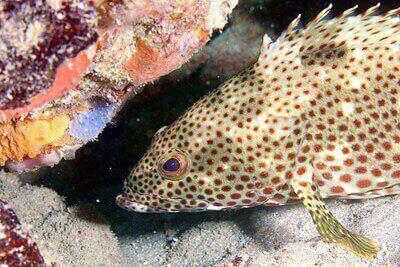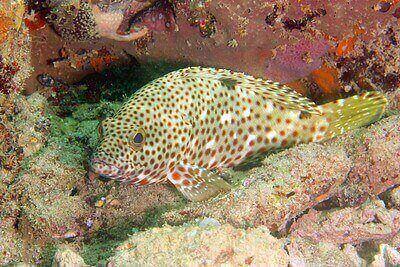Disclosure: We may earn commissions if you purchase products after clicking on a link from our site.
Are you interested in learning how to catch rock hind? Do you want to challenge yourself with fishing for rock hind? Rock hind is an elusive and reclusive fish. It shies away from human interaction. It is a solitary fish often found near ports, jetties, shipwrecks, rocks, snapper banks, roman-made reefs, and other structures.
In this article, we discuss how to catch rock hind as well as the fishing methods used, and fishing tackle, and share other information to improve your chances of catching rock hinds.

Table of Contents
How To Catch Rock Hind
Rock Hind is often found at the bottom where they prey on crabs, squid, mackerel, sardines, and other baitfish. They can be found around structures at the bottom and in breakwaters near ports. Trolling, drift fishing, and bottom bouncing are some of the methods used by anglers to catch Rock Hind.
1. Trolling
Trolling is a productive fishing method used to target rock hind in deeper waters where they may roam in search of prey. Anglers employing this technique typically use a boat equipped with multiple fishing lines trailing behind at varying depths and distances.
The key to successful trolling for rock hind lies in presenting lures or baits that mimic their natural prey, such as small fish or squid, at the appropriate depth and speed. Anglers can utilize downriggers or planer boards to control the depth at which their lures or baits are presented, ensuring they reach the desired depth where rock hind are likely to be found.
Additionally, adjusting trolling speed to match the fish’s preferred swimming speed can increase the effectiveness of this method. Anglers should focus their efforts near rocky reefs, ledges, or drop-offs, where rock hind are known to congregate.
To optimize trolling success, anglers should experiment with different lure colors, sizes, and trolling speeds until they find a combination that entices strikes from rock hind. For more information on how to catch rock hind using trolling techniques, anglers can consult resources provided by the National Oceanic and Atmospheric Administration (NOAA): NOAA Fishing Guidelines.
2. Drift Fishing
Drift fishing is a versatile and effective method employed by anglers to target rock hind, particularly in areas with strong currents or over expansive rocky habitats where these fish are commonly found. Anglers utilizing this technique typically allow their bait or lure to drift naturally with the current while covering a broad area.
Drift fishing allows anglers to present their offerings at various depths and angles, increasing the likelihood of enticing strikes from rock hind hiding within rocky crevices or patrolling the waters nearby. To effectively catch rock hind through drift fishing, anglers can use a variety of baits, including live or dead baitfish, squid, or cut bait, rigged on appropriate tackle to withstand the conditions and depths being fished.
Additionally, anglers may choose to employ drift fishing in combination with other techniques such as bottom fishing or jigging to further enhance their chances of success. By adjusting drift speed, bait presentation, and location based on water conditions and fish behavior, anglers can optimize their drift fishing strategy for targeting rock hind.

3. Bottom Fishing
Bottom fishing is a popular and effective technique employed by anglers to target rock hind, particularly around rocky structures and reef habitats where these fish are abundant. This method involves presenting baited hooks or lures directly on or near the seabed, where rock hind often forage for food.
Anglers typically anchor their boat or drift slowly over promising spots while keeping their lines in constant contact with the bottom. Baits commonly used for bottom fishing for rock hind include live or cut baitfish, squid, shrimp, or crabs, depending on local preferences and availability. Anglers may also opt for artificial lures designed to mimic the movement and appearance of natural prey.
Rigging setups for bottom fishing can vary but often involve a sliding sinker or a weighted jighead to keep the bait near the seabed and minimize snags. Patience and keen observation are essential when bottom fishing for rock hind, as strikes may be subtle or occur when the fish takes the bait and retreats to its rocky lair.
Anglers should be prepared to adjust their bait presentation, depth, and location based on factors such as tide, current, and structure to maximize their chances of success. For more comprehensive guidance on bottom fishing techniques for targeting rock hind, anglers can refer to resources provided by the National Oceanic and Atmospheric Administration (NOAA): NOAA Fishing Guidelines.
4. Bottom Bouncing
Bottom bouncing is a highly effective fishing method commonly used to target rock hind, particularly in areas with rugged underwater terrain or rocky structures where these fish tend to congregate. This technique involves vertically jigging or bouncing a weighted lure or rig along the seabed, enticing strikes from rock hind hiding in crevices or near rocky outcrops.
Anglers typically use specialized rigs equipped with heavy sinkers or jigheads and multiple hooks baited with live or cut baitfish, squid, or other natural baits favored by rock hind. The key to successful bottom bouncing lies in maintaining constant contact with the bottom while imparting subtle movements to the bait to mimic the erratic behavior of injured prey.
Anglers may need to adjust the weight of their rigs or the length of their leaders to ensure their baits remain within striking distance of rock hind lurking near the seabed. Bottom bouncing requires patience, precision, and a keen understanding of the underwater terrain to avoid snagging and effectively target rock hind.
Anglers should focus their efforts around rocky reefs, drop-offs, and underwater ledges where rock hind are known to feed and seek shelter. For more detailed guidance on bottom bouncing techniques for catching rock hind, anglers can consult resources provided by the National Oceanic and Atmospheric Administration (NOAA): NOAA Fishing Guidelines.
5. Spearfishing
Spearfishing is a popular method used to catch rock hind, especially in areas where they inhabit rocky reefs and ledges. Divers equipped with snorkeling or scuba gear use a spear gun or pole spear to target rock hind hiding within crevices and caves. This method requires skill and patience as divers must approach the fish cautiously to get within range for an accurate shot.
Once spotted, divers aim for a precise shot to immobilize the fish quickly and prevent it from retreating into the reef. Successful spearfishing for rock hind often involves understanding the fish’s behavior and habitat preferences, as well as employing proper diving techniques.
For more information on spearfishing regulations and best practices, anglers can refer to resources provided by the National Oceanic and Atmospheric Administration (NOAA): NOAA Spearfishing Guidelines.
6. Rod and Reel Fishing
Rod and reel fishing is another common method used to catch rock hind, particularly for anglers targeting them from boats or shorelines near rocky structures. Anglers typically use medium to heavy spinning or baitcasting tackle equipped with appropriate line strength to handle the fish’s strong fighting abilities and the rugged underwater terrain.
Effective baits for rock hind include live or dead baitfish, squid, cut bait, and artificial lures resembling small fish or crustaceans. Anglers can present their baits near rock formations, drop-offs, or ledges where rock hind are likely to congregate.
Successful rod and reel fishing for rock hind requires anglers to know the fish’s behavior and feeding habits, as well as the ability to effectively maneuver their gear in rocky environments. For more information on rod and reel fishing regulations and techniques, anglers can consult resources provided by the U.S. Fish and Wildlife Service (USFWS): USFWS Fishing Regulations.
7. Handline Fishing
Handline fishing is a traditional and straightforward method used to catch rock hind, particularly from small boats or rocky shorelines. Anglers use a simple handline consisting of a spool of fishing line with a weighted hook or lure attached to one end.
By lowering the baited hook or lure into the water and manually controlling the line’s movement, anglers can present their offering near underwater structures where rock hind are likely to be found. Handline fishing requires minimal equipment and is suitable for anglers of all skill levels.
Successful handline fishing for rock hind often involves patience and persistence, as well as knowledge of the fish’s behavior and preferred habitat. For more information on handline fishing techniques and safety tips, anglers can refer to resources provided by the National Park Service (NPS): NPS Fishing Guidelines.

Best Baits and Lures For Rock Hind
- Squid
Squid is a highly effective and versatile bait commonly used by anglers targeting rock hind. This cephalopod possesses a strong scent and texture that entices rock hind, making it a popular choice for both bottom fishing and trolling. Anglers often use fresh or frozen squid, either whole or cut into strips, to mimic the natural prey of rock hind.
When bottom fishing, squid can be threaded onto hooks or jigs and presented near the seabed, where rock hind are known to forage. The soft texture of squid allows it to move naturally in the water, attracting the attention of nearby fish.
Additionally, squid can be used as trailing bait when trolling, either rigged behind artificial lures or fished on downriggers to target rock hind at various depths. Anglers may enhance the effectiveness of squid bait by adding scent attractants or dye to increase its visibility and appeal to rock hind in low-light conditions or murky waters. Squid is readily available at most tackle shops and seafood markets, making it a convenient and reliable bait option for anglers pursuing rock hind.
2. Mackerel
Mackerel is a highly effective and widely used bait for targeting rock hind, prized for its oily flesh and strong scent that attracts these predatory fish. Anglers often use fresh or frozen mackerel, either whole or cut into chunks, as bait when bottom fishing for rock hind.
The oily nature of mackerel releases a scent trail in the water that can lure rock hind from a distance, making it an excellent choice for enticing these elusive fish. Mackerel can be rigged on a variety of bottom fishing rigs, including dropper loops, fish finder rigs, or sliding sinker rigs, depending on the fishing conditions and angler preference.
When presenting mackerel as bait, anglers typically aim to keep the bait near the seabed, where rock hind are known to forage for prey. Additionally, mackerel can be used as a trolling bait, either rigged behind artificial lures or fished on downriggers to target rock hind at different depths.
Anglers may also choose to brine or marinate mackerel in fish attractants or natural oils to enhance its appeal and increase its effectiveness as bait for rock hind. Mackerel can be readily purchased at most bait shops or seafood markets, providing anglers with a convenient and reliable bait option for pursuing rock hind.
3. Sardines
Sardines are a popular and effective bait choice for anglers targeting rock hind. These small, oily fish emit a strong scent that attracts rock hind, making them an enticing option for both bottom fishing and trolling. Anglers typically use fresh or frozen sardines, either whole or cut into strips or chunks, to mimic the natural prey of rock hind.
When bottom fishing, sardines can be threaded onto hooks or jigs and presented near the seabed, where rock hind are known to forage. The oily texture of sardines creates a scent trail in the water, which can lure rock hind from a distance and increase the chances of a successful catch.
Additionally, sardines can be rigged behind artificial lures or fished on downriggers when trolling to target rock hind at various depths. Anglers may enhance the effectiveness of sardine bait by adding scent attractants or dye to increase its visibility and appeal, particularly in low-light conditions or murky waters. Sardines are readily available at most bait shops and seafood markets, providing anglers with a convenient and reliable bait option for pursuing rock hind.

4. White Crabs
White crabs are a popular and effective bait choice for anglers targeting rock hind. These crustaceans are abundant in coastal waters and are known to be a natural prey item for rock hind. When used as bait, white crabs emit a strong scent that attracts rock hind, making them highly enticing for bottom fishing.
Anglers typically use live or freshly killed white crabs, rigging them onto hooks or jigs and presenting them near the seabed, where rock hind are known to forage. The natural movements and scent of white crabs help draw the attention of rock hind, increasing the likelihood of a successful catch.
Additionally, white crabs can be used in combination with other baits or attractants to enhance their effectiveness further. Anglers may choose to fish with whole crabs or use crab sections to target specific areas of interest on the seabed. White crabs are readily available at most bait shops or can be collected by anglers themselves along rocky shorelines or in tidal pools.
5. Jigs
Jigs are a versatile and effective lure choice for anglers targeting rock hind. These artificial baits consist of a weighted head typically adorned with a colorful skirt or soft plastic body, which mimics the appearance of various prey items that rock hind feed on.
Anglers can employ jigs in a variety of fishing methods, including bottom fishing, drift fishing, and vertical jigging, making them suitable for different fishing scenarios and water conditions. When targeting rock hind with jigs, anglers often present the lure near the seabed or rocky structures where rock hind are known to congregate.
The erratic movements of jigs, combined with their vibrant colors and realistic appearance, can trigger aggressive strikes from rock hind. Anglers can experiment with different jig sizes, weights, and colors to match the prevailing conditions and preferences of the fish.
Additionally, jigs can be tipped with natural bait such as squid, mackerel, or white crabs to enhance their effectiveness further. Overall, jigs offer anglers a versatile and productive option for enticing rock hind and can be a valuable addition to any angler’s tackle box.

Rock Hind vs Red Hind
| Characteristic | Rock Hind | Red Hind |
|---|---|---|
| Behavior | More reclusive | Less reclusive |
| Tail | Spotted with no black margin | Not spotted and has a black margin |
| Tail & Anal Fins | Have broad white outlines | Don’t have broad white outlines |
| Can change? | Yes; turns pale or darkens | No |
| Dark Splotches | Has 1 to 4 pale or dark splotches on its back | Don’t have dark splotches on its back |
| Found In Shallow Water? | No | Yes |
Rock Hind Fishing Tips
- Rock Hind is a solitary fish that can be found around wrecks, artificial reefs, rocks, ports, jetties, snapper banks, roman-made reefs, and other structures.
2. Rock Hinds are bottom feeders and feed usually at dusk.
3. The best time to go fishing for Rock Hind is from March to September during the coldest time of the year.

4. Rock Hinds fight ferociously when hooked.
5. Trolling, drift fishing, bottom fishing, and bottom bouncing are some of the fishing methods used by anglers to catch rock hind.
6. Crabs, squid, mackerel, and sardines are some of the baits to use when learning how to catch rock hind.
7. Jigs work well when fishing for rock hind and implementing bottom bouncing.

8. Rock Hinds usually hunt for prey at the bottom at dusk.
9. Rock Hinds are known for going to their hideouts around structures when hooked. This can easily break the line. Therefore, when you feel the bite and noticed that the line is caught by some object, stop pulling. Your best strategy is to let the rock hind try to free itself until it gets tired.
10. Don’t grab rock hinds by their gill covers, especially if it is a large one as the gill covers are jagged sharp and the rock hind has a lot of strength.

The Bottom Line
Rock Hind is a fish in the grouper family that is often found at the bottom preying on crabs, small fish, and squid. It is elusive and fights hard when caught. Trolling, drift fishing, bottom fishing, and bottom bouncing are some of the fishing methods used when learning how to catch rock hind. If you fish for grouper, you can read how to catch grouper, how to catch black grouper, and how to catch gag grouper to learn more tips to catch more grouper.